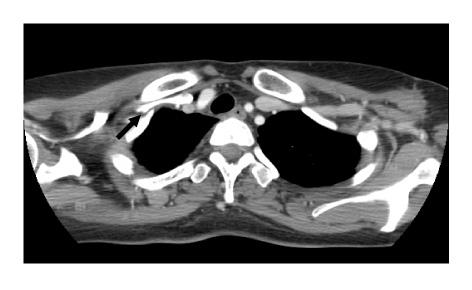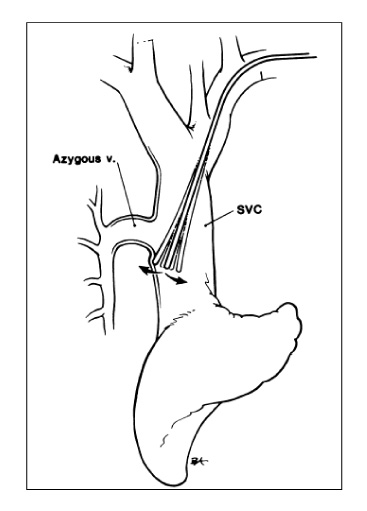Tuberc Respir Dis.
2006 Jun;60(6):690-693. 10.4046/trd.2006.60.6.690.
A Case of Pleural Effusion after Malposition of Central Venous Catheter
- Affiliations
-
- 1Department of Internal Medicine, Yonsei University Wonju College of Medicine, Wonju, Korea. sjyong@yonsei.ac.kr
- 2Department of Radiology, Yonsei University Wonju College of Medicine, Wonju, Korea.
- KMID: 1630809
- DOI: http://doi.org/10.4046/trd.2006.60.6.690
Abstract
- Central venous catheterization is used to provide a large amount of fluid, total parenteral nutrition and to administer antitumor agents with few complications reported. We report an uncommon case of pleural effusion that occurred after central venous catheterization. In many cases, the mechanism for the pleural effusion after central venous catheterization occurs through an injury to the superior vena cava by the continuous mechanical force of the catheter tip, the flow of large amount of fluid and an osmotic injury to the wall of the vein. This case is somewhat different in that the central catheter was placed in an aberrant vessel resulting in the pleural effusion. A post-placement chest roentgenogram and the correct approach of catheterization are important for preventing this complication.
MeSH Terms
Figure
Cited by 1 articles
-
Interpleural Displacement of Subclavian Catheter During Thoracotomy - A Case Report -
Ji-Wook Kim, Dong-hee Gang, Doo-Sik Kim, Se-Hwan Kim, Soo-bong Yu, Sie-Jeong Ryu
Kosin Med J. 2012;27(2):191-194. doi: 10.7180/kmj.2012.27.2.191.
Reference
-
1. Olivares Lopez A, Borras Rubio E, Sanchez Ortega JL, Fernandez Contreras R, Riquelme MR, Lopez Rodriguez F. Iatrogenic hydrothorax after catheterization of the left internal jugular vein. Rev Esp Anestesiol Reanim. 1991. 38:189–191.2. Colon R, Frazier OH. Right hydrothorax after left subclavian and internal jugular vein catheterization: a delayed complication. Tex Heart Inst J. 1985. 12:389–392.3. Paw HG. Bilateral pleural effusions: unexpected complication after left internal jugular venous catheterization for total parenteral nutrition. Br J Anaesth. 2002. 89:647–650.4. Campagnutta E, Segatto A, Maesano A, Sopracordevole F, Visentin MC, Scarabelli C. Bilateral hydrothorax with hydromediastinum after cannulation of the left internal jugular vein. Minerva Ginecol. 1989. 41:479–483.5. Tayama K, Inoue T, Yokoyama H, Yano T, Ichinose Y. Late development of hydrothorax induced by a central venous catheter: report of a case. Surg Today. 1996. 26:837–838.6. Ishibashi H, Ohta K, Ochiai T, Kaisan T, Ishikawa T, Kubota T, et al. Delayed hydrothorax induced by a pericutaneous central venous catheter; report of a case. Kyobu Geka. 2002. 55:213–215.7. McDonnell PJ, Qualman SJ, Hutchins GM. Bilateral hydrothorax as a life-threatening complication of central venous hyperalimentation. Surg Gynecol Obstet. 1984. 158:577–579.8. Porcel JM. Unilateral pleural effusion secondary to brachiocephalic venous thrombosis: a rare complication of central vein catheterization. Respiration. 2002. 69:569.9. Dhande V, Kattwinkel J, Alford B. Recurrent bilateral pleural effusions secondary to superior vena cava obstruction as a complication of central venous catheterization. Pediatrics. 1983. 72:109–113.10. Currarino G. Migration of jugular or subclavian venous catheters into inferior tributaries of the brachiocephalic veins or into the azygos vein, with possible complications. Pediatr Radiol. 1996. 26:439–449.11. Lee AC, Patel JV, Picton SV, Squire R. Internal thoracic vein cannulation as a complication of central venous catheter insertion. Med Pediatr Oncol. 2003. 40:195–196.12. Jung KS. Mechanism of pleural effusion. Tuberc Respir Dis. 1999. 47:141–149.
- Full Text Links
- Actions
-
Cited
- CITED
-
- Close
- Share
- Similar articles
-
- Central Venous Catheter-Related Hydrothorax
- A Case of Unilateral Pleural Effusion Due to Percutaneously Inserted Central Venous Catheterization
- Pleural Effusion and Diaphragmatic Palsy Associated with Peripherally Inserted Central Venous Catheter in a Preterm Infant
- Tension hydrothorax induced by malposition of central venous catheter: A case report
- Mediastinal and Intrapleural Hydrothorax Following Subclavian Central Venous Catheterization - A case report





